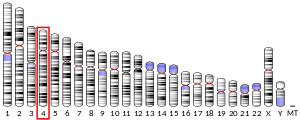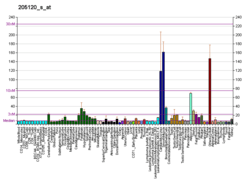SGCB
Beta-sarcoglycan is a protein that in humans is encoded by the SGCB gene.[5][6]
| SGCB | |||||||||||||||||||||||||
|---|---|---|---|---|---|---|---|---|---|---|---|---|---|---|---|---|---|---|---|---|---|---|---|---|---|
| Identifiers | |||||||||||||||||||||||||
| Aliases | SGCB, A3b, LGMD2E, SGC, sarcoglycan beta, LGMDR4 | ||||||||||||||||||||||||
| External IDs | OMIM: 600900 MGI: 1346523 HomoloGene: 195 GeneCards: SGCB | ||||||||||||||||||||||||
| |||||||||||||||||||||||||
| |||||||||||||||||||||||||
| |||||||||||||||||||||||||
| Orthologs | |||||||||||||||||||||||||
| Species | Human | Mouse | |||||||||||||||||||||||
| Entrez | |||||||||||||||||||||||||
| Ensembl | |||||||||||||||||||||||||
| UniProt | |||||||||||||||||||||||||
| RefSeq (mRNA) | |||||||||||||||||||||||||
| RefSeq (protein) | |||||||||||||||||||||||||
| Location (UCSC) | Chr 4: 52.02 – 52.04 Mb | Chr 5: 73.63 – 73.65 Mb | |||||||||||||||||||||||
| PubMed search | [3] | [4] | |||||||||||||||||||||||
| Wikidata | |||||||||||||||||||||||||
| |||||||||||||||||||||||||
The dystrophin-glycoprotein complex (DGC) is a multisubunit protein complex that spans the sarcolemma and provides structural linkage between the subsarcolemmal cytoskeleton and the extracellular matrix of muscle cells. There are 3 main subcomplexes of the DGC: the cytoplasmic proteins dystrophin (DMD; MIM 300377) and syntrophin (SNTA1; MIM 601017), the alpha- and beta-dystroglycans (see MIM 128239), and the sarcoglycans (see, e.g., SGCA; MIM 600119) (Crosbie et al., 2000).[supplied by OMIM][6]
References
- GRCh38: Ensembl release 89: ENSG00000163069 - Ensembl, May 2017
- GRCm38: Ensembl release 89: ENSMUSG00000029156 - Ensembl, May 2017
- "Human PubMed Reference:". National Center for Biotechnology Information, U.S. National Library of Medicine.
- "Mouse PubMed Reference:". National Center for Biotechnology Information, U.S. National Library of Medicine.
- Bonnemann CG, Passos-Bueno MR, McNally EM, Vainzof M, de Sa Moreira E, Marie SK, Pavanello RC, Noguchi S, Ozawa E, Zatz M, Kunkel LM (Mar 1997). "Genomic screening for beta-sarcoglycan gene mutations: missense mutations may cause severe limb-girdle muscular dystrophy type 2E (LGMD 2E)". Hum Mol Genet. 5 (12): 1953–61. doi:10.1093/hmg/5.12.1953. PMID 8968749.
- "Entrez Gene: SGCB sarcoglycan, beta (43kDa dystrophin-associated glycoprotein)".
Further reading
- Yoshida M, Ozawa E (1991). "Glycoprotein complex anchoring dystrophin to sarcolemma". J. Biochem. 108 (5): 748–52. doi:10.1093/oxfordjournals.jbchem.a123276. PMID 2081733.
- Lim LE, Duclos F, Broux O, et al. (1995). "Beta-sarcoglycan: characterization and role in limb-girdle muscular dystrophy linked to 4q12". Nat. Genet. 11 (3): 257–65. doi:10.1038/ng1195-257. PMID 7581448.
- Bönnemann CG, Modi R, Noguchi S, et al. (1995). "Beta-sarcoglycan (A3b) mutations cause autosomal recessive muscular dystrophy with loss of the sarcoglycan complex". Nat. Genet. 11 (3): 266–73. doi:10.1038/ng1195-266. PMID 7581449.
- Duggan DJ, Gorospe JR, Fanin M, et al. (1997). "Mutations in the sarcoglycan genes in patients with myopathy". N. Engl. J. Med. 336 (9): 618–24. doi:10.1056/NEJM199702273360904. PMID 9032047.
- Fougerousse F, Durand M, Suel L, et al. (1998). "Expression of genes (CAPN3, SGCA, SGCB, and TTN) involved in progressive muscular dystrophies during early human development". Genomics. 48 (2): 145–56. doi:10.1006/geno.1997.5160. PMID 9521867.
- Duclos F, Broux O, Bourg N, et al. (1998). "Beta-sarcoglycan: genomic analysis and identification of a novel missense mutation in the LGMD2E Amish isolate". Neuromuscul. Disord. 8 (1): 30–8. doi:10.1016/S0960-8966(97)00135-1. PMID 9565988.
- Bönnemann CG, Wong J, Ben Hamida C, et al. (1998). "LGMD 2E in Tunisia is caused by a homozygous missense mutation in beta-sarcoglycan exon 3". Neuromuscul. Disord. 8 (3–4): 193–7. doi:10.1016/S0960-8966(98)00014-5. PMID 9631401.
- Chan YM, Bönnemann CG, Lidov HG, Kunkel LM (1999). "Molecular organization of sarcoglycan complex in mouse myotubes in culture". J. Cell Biol. 143 (7): 2033–44. doi:10.1083/jcb.143.7.2033. PMC 2175228. PMID 9864373.
- dos Santos MR, Jorge P, Ribeiro EM, et al. (2000). "Noval mutation (Y184C) in exon 4 of the beta-sarcoglycan gene identified in a Portuguese patient. Mutations in brief no. 177. Online". Hum. Mutat. 12 (3): 214–5. PMID 10660328.
- Barresi R, Di Blasi C, Negri T, et al. (2000). "Disruption of heart sarcoglycan complex and severe cardiomyopathy caused by beta sarcoglycan mutations". J. Med. Genet. 37 (2): 102–7. doi:10.1136/jmg.37.2.102. PMC 1734518. PMID 10662809.
- Durbeej M, Cohn RD, Hrstka RF, et al. (2000). "Disruption of the beta-sarcoglycan gene reveals pathogenetic complexity of limb-girdle muscular dystrophy type 2E" (PDF). Mol. Cell. 5 (1): 141–51. doi:10.1016/S1097-2765(00)80410-4. PMID 10678176.
- Yoshida M, Hama H, Ishikawa-Sakurai M, et al. (2000). "Biochemical evidence for association of dystrobrevin with the sarcoglycan-sarcospan complex as a basis for understanding sarcoglycanopathy". Hum. Mol. Genet. 9 (7): 1033–40. doi:10.1093/hmg/9.7.1033. PMID 10767327.
- Fanin M, Hoffman EP, Angelini C, Pegoraro E (2000). "Private beta- and gamma-sarcoglycan gene mutations: evidence of a founder effect in Northern Italy". Hum. Mutat. 16 (1): 13–7. doi:10.1002/1098-1004(200007)16:1<13::AID-HUMU3>3.0.CO;2-V. PMID 10874299.
- Radojevic V, Lin S, Burgunder JM (2000). "Differential expression of dystrophin, utrophin, and dystrophin-associated proteins in human muscle culture". Cell Tissue Res. 300 (3): 447–57. doi:10.1007/s004410000213. PMID 10928275.
- Crosbie RH, Lim LE, Moore SA, et al. (2000). "Molecular and genetic characterization of sarcospan: insights into sarcoglycan-sarcospan interactions". Hum. Mol. Genet. 9 (13): 2019–27. doi:10.1093/hmg/9.13.2019. PMID 10942431.
- Barresi R, Moore SA, Stolle CA, et al. (2001). "Expression of gamma -sarcoglycan in smooth muscle and its interaction with the smooth muscle sarcoglycan-sarcospan complex". J. Biol. Chem. 275 (49): 38554–60. doi:10.1074/jbc.M007799200. PMID 10993904.
- Wakayama Y, Inoue M, Kojima H, et al. (2002). "Localization of sarcoglycan, neuronal nitric oxide synthase, beta-dystroglycan, and dystrophin molecules in normal skeletal myofiber: triple immunogold labeling electron microscopy". Microsc. Res. Tech. 55 (3): 154–63. doi:10.1002/jemt.1166. PMID 11747090.
- Fanin M, Angelini C (2002). "Defective assembly of sarcoglycan complex in patients with beta-sarcoglycan gene mutations. Study of aneural and innervated cultured myotubes". Neuropathol. Appl. Neurobiol. 28 (3): 190–9. doi:10.1046/j.1365-2990.2002.00389.x. PMID 12060343.
- Wheeler MT, Zarnegar S, McNally EM (2003). "Zeta-sarcoglycan, a novel component of the sarcoglycan complex, is reduced in muscular dystrophy". Hum. Mol. Genet. 11 (18): 2147–54. doi:10.1093/hmg/11.18.2147. PMID 12189167.
This article is issued from Wikipedia. The text is licensed under Creative Commons - Attribution - Sharealike. Additional terms may apply for the media files.





